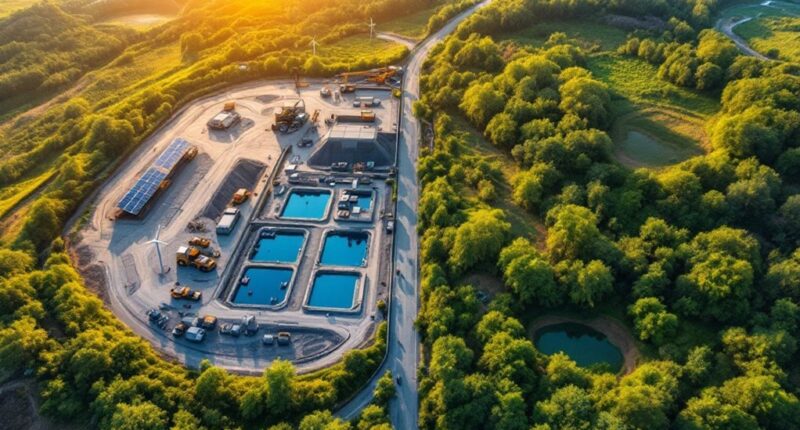Modern mining is evolving beyond its dirty reputation through innovative sustainability practices. Companies now reprocess tailings to extract remaining minerals, implement closed-loop water systems, and integrate renewable energy at mine sites. Land restoration efforts create wildlife corridors and transform mined areas into agricultural or recreational spaces. Community engagement guarantees local populations benefit from operations, while technologies like precision drilling minimize ecological footprints. These practices represent the golden nuggets of an industry digging its way toward environmental responsibility.

While the mining industry has long been viewed as environmentally destructive, a remarkable transformation is taking place beneath the surface of this perception. As companies pivot toward sustainability, mining operations worldwide are implementing innovative solutions that minimize ecological footprints while maximizing resource extraction – like trying to have your mineral cake and preserve the environment too.
Waste management has undergone a radical rethink, with tailings – mining’s version of leftovers – now being reprocessed to extract remaining valuable minerals. What was once discarded as worthless rock now finds new life in construction projects, turning yesterday’s trash into today’s infrastructure treasure.
Water circuits have gone from one-way streets to roundabouts, with closed-loop systems dramatically reducing consumption while advanced filtration guarantees what does get discharged meets strict quality standards. In-situ mining techniques have revolutionized the industry by extracting minerals without removing ore, resulting in minimal surface disturbance and preservation of vital ecosystems.
The energy powering these operations is getting a green makeover as well. Solar panels and wind turbines are popping up at mine sites like mushrooms after rain, contributing to an ambitious goal of 1 GW of renewable energy across global mining operations.
Mining vehicles, once exclusively gas-guzzling behemoths, are increasingly running on electricity or hybrid systems. These cleaner alternatives are a critical component in the industry’s efforts to reduce carbon footprint and combat climate change.
Post-mining landscapes are no longer being abandoned like yesterday’s fashion trends. Companies now restore mined lands to their natural state or transform them into agricultural or recreational spaces. These restoration efforts often incorporate forest management principles to ensure ecological balance while providing sustainable resources for future generations.
Wildlife corridors guarantee local critters don’t need to pack their tiny suitcases and move away permanently, while biodiversity action plans help preserve native flora and fauna.
Community engagement has evolved from an afterthought to a cornerstone of responsible mining. Local populations are now active participants in decision-making processes, benefiting from job creation, economic support, and transparent communication.
Technological innovations like precision drilling, real-time environmental monitoring, and autonomous equipment are revolutionizing the industry’s efficiency while reducing its environmental impact.
Meanwhile, regulatory frameworks like the Initiative for Responsible Mining Assurance and alignment with UN Sustainable Development Goals provide accountability and transparency.
Mining may never be completely impact-free, but these practices are helping the industry dig itself out of its unsustainable past.
Frequently Asked Questions
How Do Mining Companies Measure Their Sustainability Performance?
Mining companies measure sustainability performance through standardized frameworks like GRI, SASB, and ICMM Mining Principles.
They track specific KPIs across environmental, social, governance, and economic domains. Companies typically collect data through annual sustainability reports with third-party assurance, site-level assessments, and real-time monitoring technologies.
Performance is validated through external verification and stakeholder engagement. Industry benchmarking and continuous improvement processes help companies compare their performance, set targets, and integrate sustainability into strategic decision-making.
What Financial Incentives Exist for Adopting Sustainable Mining Practices?
Financial incentives for sustainable mining include tax credits for renewable energy adoption, cost savings from automation, and access to ESG-focused investors.
Companies can benefit from grants for early adopters, preferential utility rates for solar projects on former mining sites, and green credit programs for emission reductions.
Sustainability-linked loans with performance metrics, carbon credit trading, and alignment with UN Sustainable Development Goals provide additional incentives, allowing mining operations to profit while reducing environmental impact.
Can Abandoned Mines Be Safely Repurposed for Other Uses?
Abandoned mines can indeed be safely repurposed with proper engineering and environmental remediation.
Former excavation sites now host everything from underground data centers to recreational facilities like theme parks and amphitheaters.
Environmental rehabilitation transforms mining scars into botanical gardens and wetland habitats.
Economic revitalization efforts include renewable energy installations and specialized agriculture.
Scientific and cultural uses range from research facilities to museums.
Each repurposing project requires thorough assessment of structural stability, contamination levels, and ongoing maintenance requirements.
How Do Indigenous Communities Participate in Sustainable Mining Decisions?
Indigenous communities participate in mining decisions through several key mechanisms. They exercise Free, Prior and Informed Consent (FPIC) principles, integrate traditional knowledge into planning, and often serve on resource management boards.
Many communities have established formal agreements with mining companies, securing economic benefits through employment, training programs, and business opportunities.
Indigenous-led environmental monitoring programs guarantee cultural heritage protection.
Despite progress, challenges remain in fully implementing FPIC and improving Indigenous representation in leadership positions.
What Technologies Are Emerging to Replace Traditional Mining Methods?
Emerging technologies are revolutionizing the mining industry beyond traditional extraction methods.
Direct Lithium Extraction cuts processing time from years to hours while improving resource utilization.
In-situ mining dissolves minerals underground without removing ore, considerably reducing surface disruption.
Bioleaching employs microorganisms to extract metals from low-grade ores.
Meanwhile, autonomous and electric equipment decreases emissions and improves safety while enabling continuous operations.
These innovations promise more efficient, less environmentally damaging approaches to resource extraction.









